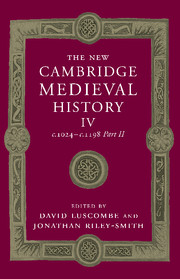Book contents
- Frontmatter
- 1 Introduction
- 2 The papacy, 1024–1122
- 3 The western empire under the Salians
- 4 Italy in the eleventh century
- 5 The kingdom of the Franks to 1108
- 6 Spain in the eleventh century
- 7 England and Normandy 1042–1137
- 8 The Byzantine Empire, 1025–1118
- 9 Kievan Rus’, the Bulgars and the southern Slavs, c. 1020 – c. 1200
- 10 Poland in the eleventh and twelfth centuries
- 11 Scandinavia in the Eleventh and Twelfth Centuries
- 12 Hungary in the Eleventh and Twelfth Centuries
- 13 The papacy, 1122–1198
- 14 The western empire, 1125–1197
- 15 Italy in the twelfth century
- 16 Spain in the twelfth century
- 17 The kingdom of the Franks from Louis VI to Philip II
- 18 England and the Angevin dominions, 1137–1204
- 19 Scotland, Wales and Ireland in the Twelfth Century
- 20 The Byzantine Empire, 1118–1204
- 21 The Latin East, 1098–1205
- 22 ’Abbasids, Fatimids and Seljuqs
- 23 Zengids, Ayyubids and Seljuqs
- Appendix: genealogical tables
- List of primary sources
- Bibliography of Secondary Works Arranged by Chapter
- Index
- Map 1a The western empire: Burgundy and Provence in the eleventh century"
- Map 1b The western empire: Germany and the north-eastern frontier of Christendom in the eleventh century"
- Map 3 The kingdom of the Franks"
- Map 4 England and Normandy"
- Map 10 Germany under Frederick Barbarossa, c. 1190">
- Map 12 The Angevin empire"
- References
21 - The Latin East, 1098–1205
Published online by Cambridge University Press: 28 March 2008
- Frontmatter
- 1 Introduction
- 2 The papacy, 1024–1122
- 3 The western empire under the Salians
- 4 Italy in the eleventh century
- 5 The kingdom of the Franks to 1108
- 6 Spain in the eleventh century
- 7 England and Normandy 1042–1137
- 8 The Byzantine Empire, 1025–1118
- 9 Kievan Rus’, the Bulgars and the southern Slavs, c. 1020 – c. 1200
- 10 Poland in the eleventh and twelfth centuries
- 11 Scandinavia in the Eleventh and Twelfth Centuries
- 12 Hungary in the Eleventh and Twelfth Centuries
- 13 The papacy, 1122–1198
- 14 The western empire, 1125–1197
- 15 Italy in the twelfth century
- 16 Spain in the twelfth century
- 17 The kingdom of the Franks from Louis VI to Philip II
- 18 England and the Angevin dominions, 1137–1204
- 19 Scotland, Wales and Ireland in the Twelfth Century
- 20 The Byzantine Empire, 1118–1204
- 21 The Latin East, 1098–1205
- 22 ’Abbasids, Fatimids and Seljuqs
- 23 Zengids, Ayyubids and Seljuqs
- Appendix: genealogical tables
- List of primary sources
- Bibliography of Secondary Works Arranged by Chapter
- Index
- Map 1a The western empire: Burgundy and Provence in the eleventh century"
- Map 1b The western empire: Germany and the north-eastern frontier of Christendom in the eleventh century"
- Map 3 The kingdom of the Franks"
- Map 4 England and Normandy"
- Map 10 Germany under Frederick Barbarossa, c. 1190">
- Map 12 The Angevin empire"
- References
Summary
the First Crusade ended with the conquest of Jerusalem on 15 July 1099, resulting in the foundation of the Latin kingdom of Jerusalem. This was to become the biggest and most important crusader state but others had been established while the crusade was en route. From the autumn of 1097 to March 1098 Baldwin of Boulogne occupied the country west and east of the Euphrates, finally taking over Edessa where he set up the county of Edessa which protected the other crusader states in the north-east. Latin rule was imposed on a predominantly Armenian population. Following the conquest of Antioch in June 1098 Bohemond I of Taranto who had been the leading figure in the long and bitter siege of the town succeeded in having his claim to Antioch recognized by the leaders of the crusading army before the crusade started to move again. Provençal attempts to curb Norman ambitions had been thwarted. Neither Baldwin nor Bohemond participated in the rest of the crusade and neither one of them adhered to a promise made earlier to the Byzantine emperor that all conquests of formerly Byzantine territories would be restored to Byzantium. Bohemond now established the principality of Antioch where a distinctly Norman ruling class governed a population partly Muslim, partly Greek. He gained legitimacy when he was invested with the principality by the patriarch of Jerusalem on Christmas 1099.
When the crusaders had reached Ramla, the old capital of Palestine, they appointed a Latin bishop there without any participation of the Greek church. In retrospect this was to become the starting-point of a Latin church in Palestine. After a siege of nearly six weeks Jerusalem was stormed and its population massacred in a blood bath. On 12 August this success was consolidated when an Egyptian army was beaten near Ascalon. Three years had passed since Godfrey of Bouillon had set out from Lorraine. Organizing the success was more difficult.
- Type
- Chapter
- Information
- The New Cambridge Medieval History , pp. 644 - 674Publisher: Cambridge University PressPrint publication year: 2004
References
- 2
- Cited by

